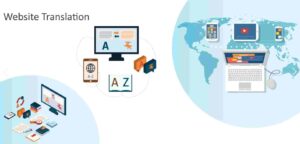Are you preparing to enter the Chinese market, but not sure if you need a Chinese website translation?
If your business wants to be successful in China, you need to make sure that your website is localized to Mandarin and optimized for display on Baidu for the keywords your target audience uses when searching for your products or services. Here are some hot issues related to website localization in China and tips on how to take your digital business in China to the next level.

1.Should I translate the whole website into Chinese?
Before you start the query, you need to determine exactly what you want to translate. Does my target Chinese audience need access to all the same information as my regular customers? If the answer is yes, then you probably do need to consider translating the entire site.
However, if you don’t have the budget to translate everything, there are other options. You can select the target login page, which contains a translated summary of your company, products, and contact information. This is a popular alternative, and see how many inquiries you get. We recommend that you translate anything that is important to help Chinese readers understand your business.
2.Should I use machine translation?
Do not use translation tools! The resulting translation is often poor. If you don’t have the budget to hire a professional web translator for your entire site, at least make sure your company’s key information is always translated by a qualified human translator.
The advantages of human translation
Having a professional Chinese translator translate your site ensures accurate language translation, localized language use, and cultural integration.
Your content will be interpreted correctly and no meaning will be lost in translation. Machine translation tools fail to interpret slogans, metaphors, idioms and other linguistic nuances, leading to meaningless literal translations.
Finally, creative translation is part of the translation process, which means that the intention, context and tone of the translated content accurately reflect the culture of the target audience.
Chinese websites optimized by professional website translators have a better user experience and are easier to rank on Baidu.
3.Who should translate Chinese websites?
Human translation is a leap forward from machine translation, but you still need to determine the final level of quality you need and who can provide it.
The first option is to have Chinese-speaking employees in your company. This is a good choice for small and simple sites. However, if they have no experience in translation or Baidu search engine optimization, they may take a relatively long time to create each page, and the quality may be just so-so. A professional Chinese translator specializing in site localization would be a perfect match. Professional Chinese website translator is not only a word master, but also proficient in website localization and Baidu search engine optimization.
4.How much does it cost to translate a website into Chinese?
The cost of translating and localizing Chinese websites varies depending on the complexity and requirements of the project. Translation agencies typically charge between $0.08 and $0.15 per source word for English/Chinese translation. However, for site translation and localization, consider the local part of the cost is higher. Typically, we charge $0.15 per Chinese character for basic site content creation, and $300 to $1,000 for key pages like the login page, about us page translation, and localization.
5.Should Chinese website design be different from English website design?
Web design in China is completely different from that in the West. If you have an e-commerce site targeted at Chinese customers, it is recommended that you cater to the tastes of the Chinese audience. However, because Chinese websites are often very complex, it may be difficult to maintain a consistent design between the English and Chinese versions of the website.
We are here to tell you that we recommend simple, useful websites. All of our previous experiences have shown that this type of design creates a better experience and higher conversion rates for users.


